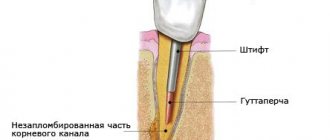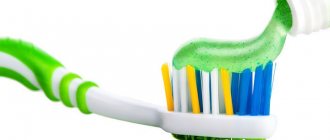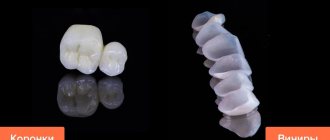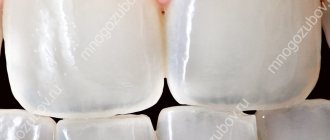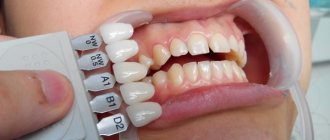What problems do temporary veneers solve?
Temporary veneers are needed:
- To protect the enamel;
- Perform a corrective function;
- Cover the treated (ground) surface of the tooth, gray and rough;
- Eliminate increased sensitivity to cold and hot foods associated with grinding teeth (unpleasant sensations will completely disappear after installing permanent veneers);
- Get used to the overlays;
- “Try on” a beautiful smile.
In the latter case, temporary veneers are a test: if the patient is satisfied with everything, you can install permanent structures, but if not, the patient will not waste his money.
During a follow-up visit to the doctor, temporary veneers are replaced with permanent ones.
Features of the use of microprostheses
Veneer is a ceramic or composite plate that replaces tooth enamel.
The installation of aesthetic onlays can be identified as a separate niche among the various methods of prosthetics. With its help, defects and shortcomings associated with the shape and length of the bone organs of the oral cavity are eliminated.
The thinnest plate can effectively mask gaps between the frontal units, stains, chips, unevenness in the enamel, and also perform a protective function if, for example, a person plays a wind instrument.
In other words, the microprostheses in question can create an ideal row without removing teeth or wearing braces for a long time.
Today in aesthetic dentistry, this technique is the only way to return a patient a beautiful smile while preserving permanent teeth. The plate is applied to the previously ground coronal part and fixed with a special adhesive solution.
It is important to note that all types of corrective non-removable plates are made from hypoallergenic mixtures.
Experts divide the fixation procedure into several stages:
- Removing a thin layer of enamel to create a rough surface. The working area is considered to be the front side of the dentition element and its sides.
- Creating an impression, taking measurements taking into account the length of the units, their rotation and existing defects.
- Covering exposed areas with temporary plates while the veneers are being made will help prevent the patient from experiencing pain while eating.
- Installation of thin microprostheses using a special fixing composition, closing gaps between teeth.
If all the plates were manufactured and installed correctly, they serve their owner for 7-10 years, and their aesthetic appearance is preserved.
But it happens that dissatisfied patients return to the clinic where dental transformations were performed with complaints of pain and discomfort that intensify day by day.
Normally, any discomfort should stop bothering a person within two weeks from the day the veneers were fixed, and should not return.
Main characteristics of E Max veneers and indications for their installation.
Come here if you are interested in what componers are and what their cost is.
At this address https://www.vash-dentist.ru/protezirovanie/nesemnyie-p/viniryi-np/duo-pch-estestvennaya-krasota.html we will look at the features of Duo PCH veneers.
Temporary veneers have disadvantages:
- Loose fit, as a result of which saliva penetrates under them;
- Lack of strong fixation;
- A simplified form that differs significantly from the form of permanent, laboratory-made veneers.
- They have the property of being painted, they quickly fail.
They cannot be used for a long time, but temporary veneers perform their main function of protecting the tooth from harmful influences until permanent structures are installed.
During the short period of time the permanent veneers are being made, the enamel will not stain.
Proper installation of temporary veneers provides the patient with the opportunity to talk and smile without embarrassment or worry about the impression they make.
Causes of complications
Any patient who wants to install the thinnest plates on their teeth primarily pursues aesthetic goals. Veneers are not able to favorably affect the functionality of chewing, but they increase self-esteem and self-confidence.
As mentioned above, the main advantage of this procedure is the preservation of natural teeth. The pulp and root part are not affected during the fixation process. If the microprosthesis darkens over time, there is always the opportunity to replace it with a new camouflage product.
Despite a number of undeniable advantages, installation of veneers can lead to a number of undesirable consequences, namely:
- Using poor quality adhesive .
Ineffective fixing solutions can create microscopic gaps between the surface layer of the unit and the plate. As a result, food particles get into the gaps and become provocateurs for the occurrence of carious lesions. - Large veneer size .
In rare cases, the parameters of the plate do not coincide with the base; its edges protrude from the sides and put pressure on the gum tissue or a nearby element, causing irritation and pain. In a number of situations, such inconsistencies lead to the appearance of microcracks in soft tissues with the subsequent development of inflammatory processes. - Very deep turning of enamel .
Filing down a layer of enamel that is too thick leads to dentin damage, which increases the susceptibility of the canals to external irritants. Teeth react painfully to contact with hot or cold food. Moreover, discomfort occurs even during a long stay in the cold. - Composite application. If a specialist applies an adhesive composition, there is a danger of drying out the hard layers, including dentin.
Over time, such an element will become covered with microcracks, chips will appear on its contours, and pathogenic microorganisms will have the opportunity to penetrate the root part and start a destructive process.
In almost all cases, pain under veneers occurs due to non-compliance with the preparation regulations by the specialist. After all, further comfort and durability of expensive camouflage products directly depends on the quality of preparatory measures.
According to statistics, in 100% of cases, painful sensations accompanied by emotional and physical discomfort develop against the background of poor enamel condition, complex straight bite, bruxism, or chronic inflammation of the gum tissue.
Also, a qualified doctor will never perform the procedure on a patient who has a history of calcium metabolism disorders.
Installation of temporary veneers
Temporary veneers are installed directly after tooth preparation. For installation, standard equipment and a silicone template are used. After polymerization, the structures are not removed; correction and polishing are done in the oral cavity. The veneers are adjusted so that diction is not distorted and conversation is comfortable. The shade is not specially selected; a neutral option is used. Aesthetics in this case does not come first. Reliability is more important.
The fixation of temporary overlays is not durable, so that there are no problems when removing them. Perhaps this design will come off. To restore the fixation, you should contact your dentist. The repeated procedure will take no more than twenty minutes. If the patient has an allergy, the doctor must be informed about this. Plastic can be replaced with a special composite mass.
Veneers: new fashion or necessity?
Veneers, thin shells on teeth, were once reserved for beautiful close-ups of movie stars, but have since moved from the big screen into the everyday lives of millions of people. It is veneers that make teeth aesthetically flawless and are strongly associated with that very Hollywood smile.
Despite their widespread popularity, veneers still raise many questions and concerns among patients. Today we tried to dispel all fears and honestly talked about veneers with Alexander Yuryevich Gaidukov, orthopedic dentist, founder of the Cosmic clinic.
— There is a feeling that veneers have not yet passed the peak of popularity; recently, more and more people are giving preference to them.
- Yes, thanks to TikTok and Instagram, thanks to the fact that veneers are now more often installed for aesthetic reasons - their popularity is growing. Previously, they were usually installed after 25, but now half of TikTokers already have veneers at the age of 18. They are just thin, beautiful, and it seems that a person has his own teeth, but these are veneers.
— So, it’s a myth that veneers don’t look like natural teeth and that they are very noticeable?
- Certainly. If your teeth are straight, veneers can be done very beautifully and discreetly. If the teeth are uneven and a person does not want to get braces, of course, it will look artificial.
— Are there indications for installing veneers?
— There are no clinical indications as such, this is an aesthetic procedure. Patients get veneers because they are dissatisfied with the color, shape of their teeth, some stains, unevenness, aesthetic defects - in general, the usual dissatisfaction with their smile. Some people have thin enamel, this can also be corrected by adding an onlay. Sometimes girls come in after lip augmentation - so that their teeth can be seen, they have to be enlarged too.
There are patients with tetracycline teeth; there used to be such an antibiotic, mothers were injected with it, and children were born with dark yellow, stained teeth. This is a clinical indication, but such cases are very rare. 95–97% is an aesthetic indication, a desire to improve your smile, make your teeth whiter, straighter, bigger.
— What procedures need to be carried out before installing veneers?
- All fillings need to be changed. The composite from which the fillings are made loses color over time and shrinks; its structure changes at the molecular level. Therefore, veneers can only be glued to a new filling. Otherwise, it may chip along with the tooth, and in the worst case, the tooth will have to be removed.
You must understand that the installation of veneers is a final procedure; before it, you need to carry out a complete sanitation of the oral cavity. If implantation or tooth extraction is required, it is better to do this before installing veneers. It is often necessary to undergo orthodontic treatment and correct the bite. For example, with a mesial bite (when the lower jaw protrudes forward), veneers are contraindicated.
— Are there any other contraindications to installing veneers?
— One of the contraindications is bruxism, which is very common now. People worry a lot, and all these experiences result in strong clenching of the teeth at night, which leads to the abrasion of the enamel. And if the tooth enamel wears off, something can happen to the veneer. Although veneer is stronger, it is attached to the enamel. Therefore, it is better to deal with bruxism before installing veneers, so that later there are no chips, cracks, or breaks of the veneer.
— Tell us more about how veneers adhere to the teeth.
— Look, before placing a filling, the teeth are etched with orthophosphoric acid to create pores in the tooth enamel into which the composite penetrates. Therefore, the filling cannot simply be picked out, it will need to be cut down along with the tooth tissues, this is called chemical bonding, adhesion.
Veneers are placed in the same way. The tooth enamel is etched, after etching it becomes dull, rough, and micropores appear. The same thing is done with veneer, only with a different acid, hydrofluoric acid - there, dullness and roughness also appear on the inner surface. And with the help of certain agents they are connected together. The result is a chemical bond: the agent penetrates both the tooth structure and the veneer structure - and bonds. They become one.
— Do you have to grind your teeth before installing veneers?
— Many patients are afraid of the word “grind,” and personally I use the word “prepare.” It doesn't always need to be sharpened. It is necessary to create conditions in order to glue the veneer. It is clear that these conditions differ from case to case, so it happens that there is no need to grind the teeth at all, but you just need to create a ledge. Sometimes the patient even walks without temporary veneers, and none of his friends see that his teeth are prepared. On average, 0.3–0.5 mm needs to be removed, which is not much.
— So, veneers are for life?
- Well, for the rest of our lives... So we get old, and our teeth decay, regardless of what structures are in place. The gums deteriorate, the bone deteriorates, the teeth become mobile. A tooth that we will have to remove due to old age may have a veneer. Something can happen to the tooth: it can get sick, caries has not been noticed, it has become hypothermic or, on the contrary, it has gotten into the heat, the temperature difference... There are a lot of such questions about veneers, but people forget that we are just getting old, our bodies are aging, and that’s it not in veneer. Why do people in their 30s and 40s have fewer teeth - because they are removed for some reason. Of course, if you take care of your teeth, this can be avoided. Come for an examination once every six months; if you have caries, treat it immediately, and not later, when your tooth hurts and you are already treating pulpitis or, God forbid, you remove a tooth and put in an implant.
- So, you installed veneers. What's next?
— If you divide the installation and care of veneers into 10 points, then the doctor will perform 9 points: he will minimally process the tooth, glue the veneers well, everything will be great. But the most important point is care. It’s the same as a new car - after buying it, you shouldn’t immediately press on the gas, you need to run it in a little, get used to it.
You need to constantly take care of your veneers and come for regular checkups. In principle, if a person gets veneers, we become friends for life. I had a patient who came in two years after the veneers were installed and said that his veneer had chipped. I thought it was strange. And then it turned out that he had not brushed his teeth at all for two years. He’s 21. And he says: “I thought I had veneers for life and don’t need to take care of them anymore!”
— Are there any special features of caring for veneers or is everything the same as with regular teeth?
- Standard care. Irrigator, brushing teeth 2 times a day, floss, brushes. It just needs to be done constantly, regularly. After eating, rinse your teeth or use a irrigator.
— Do veneers darken over time?
- No, veneers always remain the same. But veneers are transparent overlays 0.3–0.5 mm thick. They let light pass through them, and, accordingly, the teeth are also visible. Therefore, we first whiten our teeth in such a way that they do not darken in a year or two - then the color will not go away. But even under a veneer, a tooth can be whitened using trays. Teeth can also darken due to poor hygiene - stones appear, caries appears, and it’s all visible. In general, nothing will happen to them, they are ceramics.
— What to do if the veneer comes off?
— If the veneer comes off, it means that the wrong gluing technique was chosen. The correct gluing protocol means that the veneer will never come off. It can only chip. And now it can chip only because of the bite - perhaps the bite was diagnosed incorrectly. Or a patient developed bruxism after a couple of years and as a result the veneer chipped.
If a veneer is chipped, it is replaced. It is filed down under magnification, under a microscope, and carefully ground down to the tooth tissue. And after that, you need to take the impression again and glue the veneer.
— Is it possible to return teeth to their original state after veneers?
— Theoretically, if all the dental tissues are preserved, there are no fillings, we did not remove the contacts, then they can be polished. But that doesn't happen. If people get veneers, they get them forever.
— What is the difference between composite and ceramic veneers?
- The difference is quite big. The first difference is the price. Patients most often choose composite veneers because they are cheaper and faster; 8-10 teeth can be done in one visit. Composite veneer is not a solid structure; it is applied in layers, each layer needs to be polished. The composite has shrinkage, over time it loses its shine, it needs to be polished every six months, this is an additional expense. Plus it can chip.
The main disadvantage of composite veneers is their fragility. Most often, patients wear them for a year or two and see the difference from the first shiny effect, when they were just polished, to some matte Orbit chewing gum. And then they are replaced with ceramic veneers, which never change in color, shine, or anything.
— So, you recommend installing ceramic veneers?
— We have good doctors who make luxurious composite veneers, but their cost will be exorbitant. Therefore, there is little point in paying for something that will get worse over time. There is no such composite material that does not change over the years - well, it will last 5 years... But it will not last 10 years, it will need to be changed, and the price for such a veneer will be twice as high as the price in an average clinic for a ceramic one. It's like tattooing eyebrows or lips - it will go away with time anyway.
— What determines the price of veneers?
— From the doctor’s experience, from the materials used, from the experience of the technician who makes them. There are techniques that charge more, because they have smoother, more beautiful, more natural veneers, with internal details. It even depends on the location of the clinic - whether it is located somewhere in Kupchino or on Nevsky Prospekt.
— What is the normal average price for veneers?
- If you take it turnkey, with diagnostics, with the design of a new smile, with all visits - 30-45 thousand for one tooth. If you don’t have a job, just for a veneer – from 25 thousand.
— How many teeth are veneers usually installed on?
— 10–12, more often 12. Before coming up with anything with a smile design, we take a photo protocol, look at how many teeth there are in the patient’s smile line. When a patient undergoes rehabilitation with veneers, the smile becomes more relaxed, wider, and new teeth are added. If we do less than 12, the smile becomes more constrained, the patient psychologically does not smile.
— Veneers vary in thickness, shape, color?..
— The thickness depends on the clinical case, whether we need to make the tooth more voluminous or not. Much depends on the person’s face, we have different faces - oval, more round, more triangular and so on. The shape of the teeth is selected according to these data.
And the color most often chosen is artificial white. Over the years, the color becomes whiter; previously there was a request for more natural yellowish shades; now they want white ones. But you can make any, even black ones.
— What is the difference between veneers and lumineers?
— To install lumineers, you must have very even teeth and an ideal bite - then you can practically not grind down the teeth, but you still need to etch them and glue thin onlays to them (the thickness of the lumineers is 0.2 mm, editor's note).
But the downside is that they again shine through. If you put such an overlay on a table and drop water on it, you won’t see it; it will blend in color with the surface underneath it. Accordingly, you need your teeth to be white and white. Lumineers cannot make your teeth too white. You can simply increase the shape by whitening your teeth first, because the color will not change at all. But there must be a correct bite so that they do not chip, because they can just chip.
The average thickness of the veneer (0.3–0.5 mm) allows you to cover the color of the tooth and lighten it. Anything thinner doesn't work. It's all marketing.
— Are there any food restrictions with veneers?
— There are absolutely no restrictions. It is clear that beer caps do not need to be opened with them. Everything is standard, the lifestyle does not change in any way, but the strength of the teeth does not increase, so there is no need to try to chip or bite something with them.
— How to treat teeth with veneers?
— Under a microscope, with a magnification of 7–8 times. There are no more nuances here.
— What can you say to those who are afraid to install veneers because they are afraid of what will happen to them in the future?
— Many people ask what will happen in 10–15 years, but think about it: you won’t drive the same cars, wear the same clothes, or carry the same phone? Botox will change, the silicone in the breast will change. This is all a technological process. Guessing what will happen in 15 years is a utopia. We don’t know, we are not futurologists, but all this will change, of course.
— Isn’t it possible that along with the fashion for veneers, there is a standardization of smiles, an erasure of individuality to some extent?
— Now we’re in video time: we’re filming ourselves, they’re filming us, and we want us to look normal from all angles. It really improves the quality of life. When you laugh from your heart and you have no barriers, you feel much better.
Where to install temporary veneers
In the network of family dental clinics ILATAN.
- Here, experienced professionals will take care of your dental health.
- The most comfortable treatment is ensured by a caring attitude and the most modern equipment.
- To work with clients, ILATAN uses only high-quality materials.
- Temporary veneers installed in our clinics have a natural appearance.
- You can be in public places with them, laugh and smile calmly, without worrying about the appearance of your teeth.
What measures should be taken to make the pain of the tooth under the veneer disappear?
A temporary solution to the problem of pain may be to take a painkiller - this could be Dolaren, Ibuprofen or another, as recommended by your doctor.
But, of course, “living on pills” is not an option; you need to go to a dental clinic and, after diagnosing the condition of the tooth, eliminate the root cause of pain in the gum or tooth.
As a rule, patients are offered the following solution: remove the veneer, depulp the tooth (that is, drill it out and remove the sensitive nerve), treat the tooth if necessary, and only then put the veneer back. If the veneer has only come off a little, but it is intact and the tooth itself is healthy, depulpation may not be necessary. But veneers with chips and cracks definitely require complete replacement.
The specialists of the VivaDent clinic are ready to take on any case where a tooth hurts under a veneer - eliminate the pain, treat the tooth, glue or dismantle and reinstall the veneer (for example, if it was placed incorrectly in another clinic by an unqualified orthodontist). Don't hesitate to contact us!
Increased sensitivity
In some cases, pain begins to increase two weeks after restoration. This is always due to strong grinding of the protective layer. Even under the overlay, the bone organ reacts to stimuli.
To eliminate the problem, doctors resort to the following actions:
- fluoridation of the tooth on the oral side for 3-5 days;
- applying a special varnish to the surface of the unit, followed by exposure to a lamp for better hardening;
- professional cleaning from stone and bacterial plaque;
- opening of the crown, removal of the nerve bundle (in exceptional cases).
Remember! Before installing veneers, a person must understand that his teeth will never return to their original state.
If the overlay becomes deformed during operation or a chip appears on it, it will be necessary to re-make a corrective product or build up layers using composite materials.
Without an artificial protective layer, dentin is exposed to such an extent that a person simply cannot calmly eat food - attacks of intense, sharp pain are inevitable.
Does it hurt to put veneers on teeth?
Veneers are micro-prosthetic onlays, during the installation of which nerves are not removed and soft tissues are not damaged. Before installing them, a layer no more than 1.2 mm thick is removed from the tooth, and the procedure itself is preceded by anesthesia, which guarantees a complete absence of unpleasant sensations. The time required to prepare the tooth is about half an hour.
The pads do not cause discomfort when worn. After just a few days, the patient perceives the veneers as part of the teeth. The changes will only be aesthetic and for the better.
Service life
The main factor influencing the lifespan of aesthetic overlays is the material used in their manufacture. High-quality material contributes to long-term use of veneers without pain.
Porcelain is undeniably considered the most durable and highest quality. Therefore, porcelain (ceramic) plates serve their owners much longer than products made from other materials. On average, their service life reaches 8-9 years.
Composite onlays are created directly in a person’s mouth. But optimal and effective hardening takes time, so the doctor prohibits the patient from eating for 3-4 hours after the procedure.
Such veneers have a service life of no more than 5 years. However, if you strictly follow the rules of care, operation can be extended.
Zirconium dioxide plates, despite their high cost, also do not have a long service life. Although this does not prevent them from being in great demand among patients due to their high strength characteristics and natural appearance.
Whatever material the aesthetic lining is made of, after the end of its service life it must be removed for replacement.
The fact is that over the years of use, caries or inflammatory processes may develop under the product, on the surface of the tooth, requiring immediate treatment. If this is not done, the person will begin to be bothered by sensitivity and pain, increasing every day.
Stage 4. The birth of the smile of our queen - Victoria
The veneers were fixed using an adhesive technique. And in the final photo you see Victoria’s radiant smile:
We received healthy gums, healthy beautiful teeth that are absolutely no different from our own.
Only 4 veneers
, installed on the upper teeth, helped change the smile of the beautiful girl Victoria:
Well, here we go to the clinic, plus another smile from a satisfied and happy patient!
Content
- Indications for installation
- Contraindications for installation
- Installation of veneers
- What happens to teeth under veneers?
- Care after installation of veneers
The ideal natural smile is an ongoing trend. Even, beautiful teeth always give confidence and significantly enhance one’s appearance. Not everyone is lucky enough to receive such wealth from nature, which is why the service of installing veneers is very popular. The thinnest plates can not only visually improve the appearance of the dentition, but also correct minor defects.
Reviews
The advantages of veneers are obvious. For patients who do not naturally have straight and beautiful teeth, they will certainly be suitable.
They can be installed quite quickly, in just two weeks. While correcting the bite with braces followed by a whitening procedure may take about a year, or even more.
However, in some cases, after such treatment, pain may occur, the causes of which almost always lie in medical errors.
There is no need to endure discomfort; you must immediately visit a doctor, especially since all dental centers provide a guarantee for this type of work.
If you have had veneers installed before, please share with our readers whether you experienced pain and, if so, what was the reason. You can leave your feedback in the “comments” section.
If you find an error, please select a piece of text and press Ctrl+Enter.
Tags tooth pain veneers
Did you like the article? stay tuned
Previous article
Braces for children - at what age are they placed and which ones are better?
Next article
Types of complications that arise after dental prosthetics and treatment tactics
